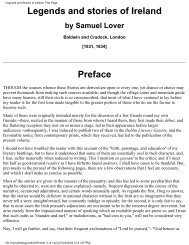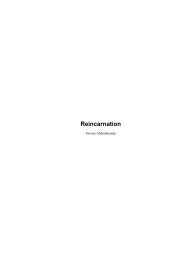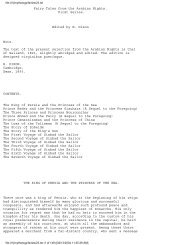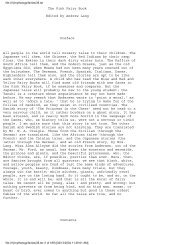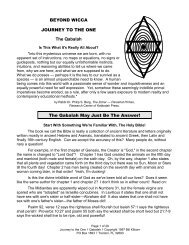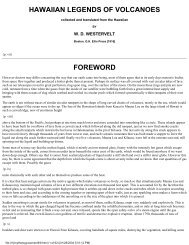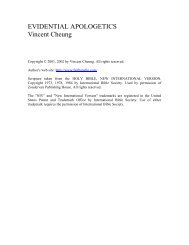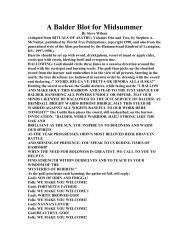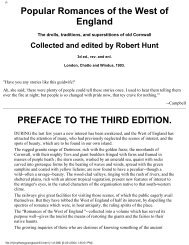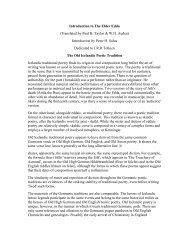Tales and Traditions of the Eskimo - Alternative Religions ...
Tales and Traditions of the Eskimo - Alternative Religions ...
Tales and Traditions of the Eskimo - Alternative Religions ...
You also want an ePaper? Increase the reach of your titles
YUMPU automatically turns print PDFs into web optimized ePapers that Google loves.
<strong>Tales</strong> <strong>and</strong> <strong>Traditions</strong> <strong>of</strong> <strong>the</strong> <strong>Eskimo</strong> - Title Page<br />
They are caught partly from kayaks, or shuttle-shaped boats, <strong>and</strong> partly from <strong>the</strong> ice <strong>and</strong> <strong>the</strong> shore.<br />
Among <strong>the</strong>ir more or less peculiar hunting contrivances we may mention: (1) Their kayaks, or boats,<br />
which consist <strong>of</strong> a framework <strong>of</strong> wood, joined toge<strong>the</strong>r principally by strings, <strong>and</strong> provided with a cover<br />
<strong>of</strong> skins impenetrable to <strong>the</strong> water. (2) The adjustment <strong>of</strong> <strong>the</strong> kayak itself <strong>and</strong> <strong>the</strong> kayak-coverings, with a<br />
view to provide an entire shelter for <strong>the</strong> kayaker, or seal-hunter, with <strong>the</strong> exception only <strong>of</strong> <strong>the</strong> face, to<br />
protect him against <strong>the</strong> water. Only a small number <strong>of</strong> <strong>Eskimo</strong> have kayaks fitted for more than a single<br />
man;1 <strong>and</strong> still more exceptionally, in <strong>the</strong> far<strong>the</strong>st north some are found who have no kayaks at all, from<br />
<strong>the</strong> sea being almost constantly frozen. (3) The adaptation <strong>of</strong> a bladder filled with air to <strong>the</strong> harpoons or<br />
javelins, in order, by retarding <strong>the</strong> animals, to prevent <strong>the</strong>m escaping after being struck, <strong>and</strong> to prevent<br />
<strong>the</strong> harpoon sinking, should <strong>the</strong> hunter miss his aim. (4) The very ingenious way in which <strong>the</strong> point <strong>of</strong><br />
<strong>the</strong>se weapons, <strong>and</strong> <strong>of</strong> <strong>the</strong> spears with which <strong>the</strong> animals are finally killed, are fitted into <strong>the</strong> shaft, so that<br />
having penetrated p. 7 <strong>the</strong> skin <strong>of</strong> <strong>the</strong> animal, <strong>the</strong> point is bent out <strong>of</strong> <strong>the</strong> shaft, which is ei<strong>the</strong>r entirely<br />
loosened, while only <strong>the</strong> point with <strong>the</strong> line <strong>and</strong> <strong>the</strong> bladder remains attached to <strong>the</strong> animal, or keeps<br />
hanging at <strong>the</strong> point. Without this precaution, <strong>the</strong> animal in its struggles would break <strong>the</strong> shaft or make<br />
<strong>the</strong> barbs slip out <strong>of</strong> its body again. (5) The sledge with <strong>the</strong> dogs trained for drawing it. In speaking <strong>of</strong><br />
<strong>the</strong>se complex contrivances as characteristic <strong>of</strong> <strong>the</strong> <strong>Eskimo</strong>, we do not claim any <strong>of</strong> <strong>the</strong>m as <strong>the</strong>ir<br />
exclusive property or invention, or as having been unknown among o<strong>the</strong>r nations now or in former ages.<br />
It would, however, be perhaps difficult to find anything at all like <strong>the</strong>ir kayaks in any o<strong>the</strong>r part <strong>of</strong> <strong>the</strong><br />
globe.<br />
Their dwellings are always <strong>of</strong> two kindsnamely, tents for <strong>the</strong> summer, <strong>and</strong> houses or huts for winter use.<br />
The tents, generally adapted for less than ten <strong>and</strong> rarely for more than twenty individuals, consist <strong>of</strong> from<br />
ten to fourteen poles, with one end raised high <strong>and</strong> leaning on <strong>the</strong> frame which forms <strong>the</strong> entrance, <strong>and</strong><br />
<strong>the</strong> whole covered over with a double layer <strong>of</strong> skins. The tents seem to be constructed in <strong>the</strong> same way<br />
everywhere, <strong>and</strong> to differ from those <strong>of</strong> neighbouring nations in having <strong>the</strong>ir highest point at <strong>the</strong> entrance<br />
in front, from which <strong>the</strong> ro<strong>of</strong> inclines towards <strong>the</strong> sides, resting all round upon a low wall <strong>of</strong> stones <strong>and</strong><br />
turf; while <strong>the</strong> neighbouring tribes generally construct <strong>the</strong>ir tents <strong>of</strong> a conical form, with <strong>the</strong> top in <strong>the</strong><br />
centre. The winter-houses are far more varied in structure. Generally <strong>the</strong>y are built <strong>of</strong> stones <strong>and</strong> turf, <strong>the</strong><br />
ro<strong>of</strong>-spars <strong>and</strong> <strong>the</strong> pillars which support <strong>the</strong> middle <strong>of</strong> <strong>the</strong> ro<strong>of</strong> being <strong>of</strong> wood. Only <strong>the</strong> <strong>Eskimo</strong> <strong>of</strong> <strong>the</strong><br />
middle regions have vaults <strong>of</strong> snow for <strong>the</strong>ir habitations; whilst <strong>the</strong> western <strong>Eskimo</strong> build <strong>the</strong>ir houses<br />
chiefly <strong>of</strong> planks, merely covered on <strong>the</strong> outside with green turf. Some <strong>of</strong> <strong>the</strong> very far nor<strong>the</strong>rn <strong>Eskimo</strong><br />
are obliged to use bones or stones instead <strong>of</strong> wood. As to <strong>the</strong> form <strong>of</strong> <strong>the</strong> houses, <strong>the</strong> passage leading into<br />
<strong>the</strong>m is long <strong>and</strong> very narrow, <strong>and</strong> p. 8 elevated towards both endsviz., <strong>the</strong> outer <strong>and</strong> <strong>the</strong> inner entrances;<br />
so that on entering <strong>the</strong> house one has first to descend, <strong>and</strong> afterwards again to ascend before reaching <strong>the</strong><br />
interior. This consists <strong>of</strong> a single apartment, only <strong>the</strong> ledge or bench for resting <strong>and</strong> sleeping on is divided<br />
into separate portions for <strong>the</strong> different families. In Greenl<strong>and</strong> <strong>the</strong> ledge or bench<strong>the</strong> "brix," as <strong>the</strong> Danes<br />
call itonly occupies one side <strong>of</strong> <strong>the</strong> house, its length being proportioned to <strong>the</strong> number <strong>of</strong> <strong>the</strong> families,<br />
whose rooms or stalls are separated by low screens, each <strong>of</strong> <strong>the</strong>se rooms having its lamp st<strong>and</strong>ing on <strong>the</strong><br />
floor in front <strong>of</strong> it. The snow-huts, from <strong>the</strong>ir circular form, are <strong>of</strong> course arranged differently; <strong>and</strong> this is<br />
also <strong>the</strong> case with <strong>the</strong> plank-houses in western <strong>Eskimo</strong>-L<strong>and</strong>, which have a cooking-place in <strong>the</strong> centre <strong>of</strong><br />
<strong>the</strong> floor, with a smoke-hole in <strong>the</strong> ro<strong>of</strong>, like <strong>the</strong> houses <strong>of</strong> <strong>the</strong> neighbouring Indians. But <strong>the</strong><br />
house-passage has generally everywhere a small side-room with a cooking-place. The provisions are<br />
sometimes kept in rooms connected with <strong>the</strong> house or house-passage; in o<strong>the</strong>r places in separate<br />
storehouses, or in caves or holes <strong>of</strong> <strong>the</strong> rocks covered with stones. In former times it seems to have been<br />
<strong>the</strong> custom at <strong>the</strong> more populous places to have a public building for meetings, especially for solemn<br />
occasions. Such buildings are still in common use among <strong>the</strong> western <strong>Eskimo</strong>: <strong>the</strong>y are also spoken <strong>of</strong> in<br />
file:///I|/mythology/american indian/24/24.html (12 <strong>of</strong> 317) [01/24/2004 8:57:48 AM]



